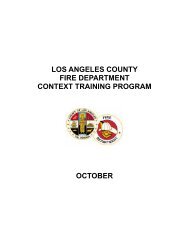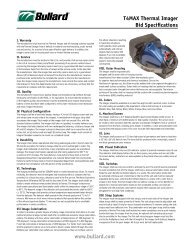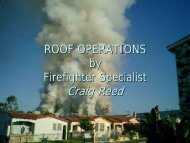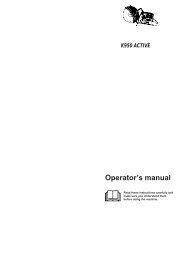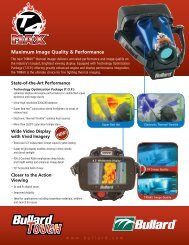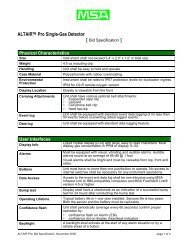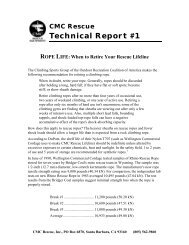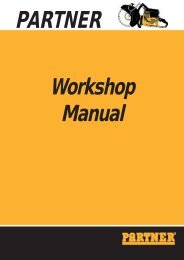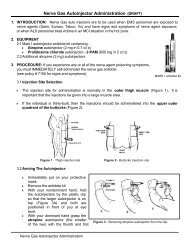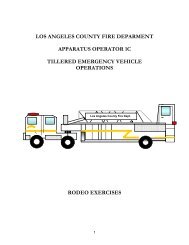Search & Rescue RIC.pdf - Los Angeles County Firefighters ...
Search & Rescue RIC.pdf - Los Angeles County Firefighters ...
Search & Rescue RIC.pdf - Los Angeles County Firefighters ...
You also want an ePaper? Increase the reach of your titles
YUMPU automatically turns print PDFs into web optimized ePapers that Google loves.
LOS ANGELES COUNTY<br />
FIRE DEPARTMENT<br />
CONTEXT TRAINING PROGRAM<br />
JANUARY
LOS ANGELES COUNTY<br />
FIRE DEPARTMENT<br />
CONTEXT TRAINING PROGRAM<br />
RAPID INTERVENTION CREWS<br />
SEARCH AND RESCUE<br />
2
3<br />
LOS ANGELES COUNTY FIRE DEPARTMENT<br />
CONTEXT TRAINING PROGRAM<br />
RAPID INTERVENTION CREWS<br />
1. Rapid Intervention Crew Procedures<br />
a. During the first alarm incidents, the IC shall designate at least two<br />
personnel (preferably one engine company and additional units as needed<br />
for specific hazards) as a standby crew or a <strong>RIC</strong>, whenever personnel are<br />
engaged in IDLH operations. At this time, consideration should be given<br />
to requesting an ambulance through Fire Command and Control for<br />
standby.<br />
b. One USAR Task Force company and one additional engine company will<br />
automatically be dispatched to all second alarm incidents (except wildland<br />
fires). Unless otherwise assigned, the USAR company should be<br />
assigned to coordinate and augment the original <strong>RIC</strong> on all multiple-alarm<br />
incidents. If USAR companies are not available, the IC may substitute a<br />
truck company, or other appropriate resources. When there are no<br />
hazardous materials situations present, consideration may be given to the<br />
use of the hazardous materials task force units to augment the <strong>RIC</strong> with<br />
manpower needs or as a <strong>RIC</strong> for confined space rescues.<br />
c. As the incident progresses, the IC/Operations shall evaluate the <strong>RIC</strong> and<br />
upgrade or create multiple <strong>RIC</strong>s as necessary to meet worsening<br />
conditions, newly discovered hazards, or incidents which grow too large to<br />
be covered by only one <strong>RIC</strong>. Multiple <strong>RIC</strong>s can be organized into a <strong>RIC</strong><br />
group for ICS organizational purposes. At the request of the IC, Fire<br />
Command and Control shall assign a separate tactical frequency for use<br />
by the <strong>RIC</strong> team.<br />
d. <strong>RIC</strong> Readiness: Upon assignment to a <strong>RIC</strong>, members shall report to a<br />
position near the command post or other area designated by the IC, in a<br />
full state of readiness. The <strong>RIC</strong> leader shall report to the incident<br />
commander (or Ops if established) to review current conditions, known<br />
hazards, locations of committed personnel and units, the incident action<br />
plan, communications plan for <strong>RIC</strong> tactical frequency, and potential rapid<br />
intervention plans. The <strong>RIC</strong> leader shall evaluate the current capabilities of<br />
the <strong>RIC</strong> and, if necessary, make recommendations to enhance the <strong>RIC</strong><br />
capabilities to match on-scene conditions. <strong>RIC</strong> shall also note the location<br />
of the incident ambulance and, if established, the Medical Base.
4<br />
LOS ANGELES COUNTY FIRE DEPARTMENT<br />
CONTEXT TRAINING PROGRAM<br />
RAPID INTERVENTION CREWS<br />
e. Personnel Accountability System Roster: Unless directed otherwise by<br />
the IC, the <strong>RIC</strong> leader shall assign a <strong>RIC</strong> member to prepare the written<br />
PAS Incident Personnel Roster, while the <strong>RIC</strong> personnel wait in the<br />
standby mode near the command post. Preparation of an accurate PAS<br />
Roster will contribute to <strong>RIC</strong> effectiveness by knowledge of personnel<br />
locations and assignments. Once the PAS Roster has been completed, it<br />
is to be given to the IC. The PAS Roster will assist the IC in accounting<br />
for all personnel during a head count.<br />
f. <strong>RIC</strong> Briefing: The <strong>RIC</strong> leader shall provide a briefing to the team<br />
members, identifying current conditions, known hazards, the locations of<br />
committed personnel and units, and tentative <strong>RIC</strong> plans of action in<br />
response to potential “fire fighter down” situations.<br />
g. <strong>RIC</strong> Equipment Pool: The <strong>RIC</strong> shall establish an equipment pool based<br />
on the hazards and <strong>RIC</strong> situations that are most likely to be encountered<br />
at the incident. The equipment pool shall be located for rapid use if a<br />
rapid intervention operation is required. The following is a guideline for<br />
<strong>RIC</strong> equipment:<br />
1. For fires, each member of the <strong>RIC</strong> should have:<br />
a. Full protective personal equipment, HT radio, with SCBA and<br />
PAL.<br />
b. One Big Beam flashlight (in addition to other flashlights)<br />
suspended on lanyard or other method.<br />
c. One drop bag.<br />
d. One forcible entry tool for escape.<br />
2. <strong>RIC</strong> equipment suggested for fires in wood frame/heavy<br />
timber/ordinary construction: Pickhead axes, pike poles, rotary saw<br />
with wood cutting blade, chain saw, sledge hammer, Haligan tool or<br />
other similar equipment. Additionally, a search rope, charged hose<br />
lines, ground ladders as needed, access to aerial ladders as<br />
needed, air bags/shoring/cribbing if collapse hazard, and a thermal<br />
imaging system when available.
5<br />
LOS ANGELES COUNTY FIRE DEPARTMENT<br />
CONTEXT TRAINING PROGRAM<br />
RAPID INTERVENTION CREWS<br />
3. <strong>RIC</strong> equipment suggested for fires in non-combustible/fire resistive<br />
construction: Halligan tool or other prying tools, sledge hammers,<br />
rotary saw with metal cutting blade and/or concrete cutting blade,<br />
cutting torch, search rope, charged hose lines, air<br />
bags/shoring/cribbing if collapse hazard, ground ladders as<br />
needed, access to aerial ladders as needed, and a thermal imaging<br />
system when available.<br />
4. <strong>RIC</strong> equipment suggested for collapse operations: Air bags,<br />
shoring and cribbing, air knife/air vacuum as needed, submersible<br />
pump as needed, torches and cutting saws, fiber optic scopes,<br />
search cameras, thermal imaging when available or as needed,<br />
other related equipment based on the hazard.<br />
5. <strong>RIC</strong> equipment for other high-risk incident types should be based<br />
on the particular hazards as recommended by technical specialists<br />
and as required by law (i.e. intrinsically safe equipment for confined<br />
space operations, etc.).<br />
h. Automatic Aid/Mutual Aid: When responded with an outside agency into<br />
their jurisdictional area, our personnel shall follow the “standby crew”<br />
guidelines and provide an outside standby crew for our own personnel,<br />
unless they have ensured that a standard <strong>RIC</strong> is being provided by the<br />
outside agency. When an outside agency is responding with us into our<br />
jurisdiction, a <strong>County</strong> of <strong>Los</strong> <strong>Angeles</strong> Fire Department unit should be<br />
utilized for <strong>RIC</strong> purposes, and the outside agency unit utilized for other<br />
assignments.<br />
i. Demobilization: The IC shall demobilize, reduce, or reassign the <strong>RIC</strong><br />
when personnel are no longer exposed to IDLH conditions. This may<br />
include the release of USAR units and/or the truck company from the <strong>RIC</strong><br />
if there are no collapse hazards or other conditions that necessitate their<br />
presence, and if a single engine company can perform the <strong>RIC</strong> functions<br />
adequately.
6<br />
LOS ANGELES COUNTY FIRE DEPARTMENT<br />
CONTEXT TRAINING PROGRAM<br />
2. “Fire Fighter Down” Procedures<br />
RAPID INTERVENTION CREWS<br />
a. Any personnel who become aware that a member is seriously injured,<br />
trapped, lost, or in need of other immediate life-saving assistance, shall<br />
immediately initiate or ensure that a “fire fighter down” notification is made.<br />
1. Request “emergency traffic” from the IC on the command and/or<br />
tactical channel and state: “Fire Fighter Down!”<br />
2. Once radio traffic has been cleared by the Fire Command and<br />
Control Facility, the individual reporting the “fire fighter down”<br />
condition shall provide as much information as possible about the<br />
nature of the situation, including the following types of information:<br />
a. The identification of the member(s) and company involved.<br />
b. The number of personnel affected.<br />
c. An accurate location of the “fire fighter down” situation.<br />
d. A brief description of the situation and any special equipment<br />
or capabilities required to find or rescue the affected<br />
personnel.<br />
e. An assessment of whether the member or company can<br />
assist in their own rescue, and the best avenues of travel to<br />
reach the “fire fighter down” site.<br />
f. Any special hazards to personnel attempting to assist.<br />
3. If unable to contact the IC, the member shall notify Fire Command<br />
and Control on the command channel. FCCF will relay the<br />
information to the IC.<br />
4. The member or company shall take whatever immediate action is<br />
necessary to safely begin search and rescue operation, to be<br />
augmented by the <strong>RIC</strong>.<br />
5. <strong>RIC</strong> operation shall begin immediately thereafter. Personnel and<br />
units that are performing critical operations (i.e. fire fighting and<br />
exposure protection in support of the rapid intervention efforts or<br />
other life-safety needs, etc.) shall discontinue those efforts if such<br />
action will result in life hazards to fire fighters or citizens. <strong>RIC</strong><br />
teams shall operate in teams of two or more.
7<br />
LOS ANGELES COUNTY FIRE DEPARTMENT<br />
CONTEXT TRAINING PROGRAM<br />
RAPID INTERVENTION CREWS<br />
b. Upon receiving a report of a “fire fighter down” emergency situation, the IC<br />
shall assign the <strong>RIC</strong> to begin search and rescue operations and notify Fire<br />
Command and Control of the situation.<br />
c. Fire Command and Control, upon receiving a report of a “fire fighter down”<br />
condition, shall immediately clear the command (and tactical, when<br />
possible) channels of all but “emergency traffic” and broadcast a “Fire<br />
Fighter Down” notification to all units operating on the incident.<br />
d. Operations section chief, branch directors, division/group supervisors,<br />
company officers, and other on-scene supervisors, upon receiving<br />
notification of a “fire fighter down” emergency, shall immediately conduct a<br />
head count to account for all personnel under their command, and report<br />
any missing personnel to the IC, through the ICS chain of command.<br />
They shall then make an assessment of their current situation and<br />
resources with respect to the ability to provide augmentation resources to<br />
assist with the <strong>RIC</strong> operation.<br />
e. The IC/Ops shall confer with the <strong>RIC</strong> to determine if additional resources<br />
are needed, and establish a formal rapid intervention plan.<br />
f. Other operating units shall continue to perform critical functions (i.e. fire<br />
fighting, exposure protection, rescue of civilians, etc.), unless otherwise<br />
directed by the IC or other supervisor.<br />
g. Companies that are not engaged in critical operations shall be made<br />
immediately available to the rapid intervention group via the IC/Ops, to<br />
support the rapid intervention. These companies should assemble in a<br />
staging area until their assistance is requested by the <strong>RIC</strong>.<br />
h. Fire Command and Control shall immediately dispatch an ambulance and<br />
will prompt the IC to consider a request for either an air squad to provide<br />
immediate air transport of injured personnel to trauma centers or an<br />
additional ground squad.
8<br />
LOS ANGELES COUNTY FIRE DEPARTMENT<br />
CONTEXT TRAINING PROGRAM<br />
RAPID INTERVENTION CREWS<br />
i. Upon entry into the area to be searched, the <strong>RIC</strong> shall remain in working<br />
teams of two or more. The <strong>RIC</strong> members would be well advised to allow<br />
for a “moment of silence” upon entry into the general search area by<br />
stopping all movement, work activity and reducing breathing/air bottle<br />
sounds. This silence will allow for “active listening” for PASS (Personal<br />
Alert Safety System) device alarms, audible sounds from injured/trapped<br />
fire fighters, or possible radio noises/squelch coming from trapped<br />
members. Frequently the trapped/lost member can be located<br />
immediately by these telltale sounds when rescuers take a moment to<br />
actually listen for them. Also scan the area for flashing light from the<br />
strobe light on the PASS device.
9<br />
LOS ANGELES COUNTY FIRE DEPARTMENT<br />
CONTEXT TRAINING PROGRAM<br />
RAPID INTERVENTION CREWS<br />
APPENDIX I<br />
Definitions<br />
COMPANY UNITY: A term to indicate that a fire company or unit shall remain together<br />
in a cohesive, identifiable working group, to ensure personnel accountability and the<br />
safety of all members. A company officer or unit leader shall be responsible for the<br />
adequate supervision, control, communication and safety of members of the company<br />
or unit. This concept is further described in the Emergency Operations Manual Volume<br />
10, Chapter 3, Subject 1, "Emergency Incident Safety Instructions."<br />
"FIRE FIGHTER DOWN" CONDITION: A term given to any situation in which<br />
personnel are reported to be lost, trapped, seriously injured, or otherwise needing<br />
immediate assistance. Whenever anyone at the incident reports "fire fighter down",<br />
Rapid Intervention Crew operations shall immediately begin. The term "fire fighter<br />
down" is being used by our Department in the interest of "clear text," however it is<br />
important for our personnel working in mutual aid and automatic aid situations to be<br />
aware that other neighboring fire agencies may utilize the terms "fire fighter red alert" or<br />
"code red."<br />
FULL STATE OF READINESS: Personnel with full protective personal equipment,<br />
SCBA, rescue ropes, entry tools, search/rescue equipment for specific hazards,<br />
available hose lines, standing by at the Command Post or other assigned location,<br />
monitoring radios and conditions of the incident, constantly ready to immediately begin<br />
search, rescue, extrication, and removal of lost, trapped, or injured fire fighters.<br />
HEAD COUNT (ROLL CALL): A term to indicate the process of conducting a "roll call"<br />
of all personnel on an emergency incident, following the order for operational retreat<br />
from a hazardous environment. The head count shall be supervised by the Incident<br />
Commander, and provide a rapid means of determining if all companies, units and<br />
individuals can be accounted for, in a place of safety. On large scale incidents,<br />
operations section chief, branch directors, division/group supervisors, strike team<br />
leaders, unit leaders, etc., shall report the results of the head count for their assigned<br />
resources to the next higher ICS level, for rapid transmittal to the Incident Commander.<br />
If any members are unaccounted for, the head count shall be repeated, and/or runners<br />
sent to verify the status .of unreported personnel.
10<br />
LOS ANGELES COUNTY FIRE DEPARTMENT<br />
CONTEXT TRAINING PROGRAM<br />
RAPID INTERVENTION CREWS<br />
IMMEDIATELY DANGEROUS TO LIFE AND HEALTH (IDLH): An atmosphere that<br />
poses an immediate threat to life, would cause irreversible adverse health effects, or<br />
would impair an individual's ability to escape from a dangerous atmosphere. Conditions<br />
present during an advanced (beyond incipient stage) interior structural fire create an<br />
Immediately Dangerous to Life and Health Atmosphere. IDLH examples include, but<br />
are not limited to, the following:<br />
A. Fires and earthquake damage to pre-1933 brick construction<br />
B. Fires and earthquake damage to facades (supported and unsupported)<br />
C. Fires in lightweight construction<br />
D. Potential flashover and backdraft conditions<br />
E. Extensive roof operations<br />
F. Fires in occupancies with large basements or large spaces where getting<br />
lost is a high potential<br />
G. Multiple fire attack teams working inside and on upper floors<br />
H. High rise fires<br />
I. Refinery fires<br />
J. Fires and other incidents in Metro Rail tunnels, mines and other<br />
subterranean locations<br />
K. Structural collapse from earthquakes, explosions, floods, wind, and other<br />
causes<br />
L. Confined space rescue<br />
M. Trench rescues<br />
N. Hazardous materials incidents<br />
O. Possible terrorism incidents<br />
P. Some transportation accidents
11<br />
LOS ANGELES COUNTY FIRE DEPARTMENT<br />
CONTEXT TRAINING PROGRAM<br />
RAPID INTERVENTION CREWS<br />
"INITIAL STAGES" OF AN INCIDENT: The period of time involving the tasks<br />
undertaken by the first arriving company with only one team assigned or operating in<br />
the hazardous area. This is the time period when two personnel remain outside the<br />
hazard area as "standby personnel," for assistance or emergency rescue at incidents<br />
requiring entry into the danger area. Once a second team is assigned or operating in<br />
the hazardous area, the incident shall no longer be considered in the "initial stage", and<br />
at least one Rapid Intervention Crew shall be required (thus also ending the time period<br />
for "standby personnel").<br />
INTERIOR STRUCTURAL FIRE FIGHTING: Refers to the physical activity of fire<br />
suppression, rescue or both, inside of buildings or enclosed structures which are<br />
involved in a fire situation beyond the incipient stage.<br />
PERSONNEL ACCOUNTABILITY SYSTEM (PAS): The term used to describe the<br />
Department's method of maintaining constant awareness of the identities and location of<br />
all personnel involved in emergency operations. This Department utilizes the ICS<br />
principles of company unity and unity of command as the cornerstone of its Personnel<br />
Accountability System. The PAS is necessary to ensure that all personnel may be<br />
quickly located after an adverse event (i.e., collapse or flashover), when an operational<br />
retreat is ordered, when a head count is requested or when a "fire fighter down" is<br />
reported.<br />
RAPID INTERVENTION CREW (<strong>RIC</strong>): A term used to describe a group of at least two<br />
personnel (preferably one engine company and additional units as needed for specific<br />
hazards) who are assembled in a full state of readiness for rapid entry, search, and<br />
rescue of other members during an emergency incident. The <strong>RIC</strong> should have a<br />
designated <strong>RIC</strong> leader, preferably an officer. Personnel assigned to a <strong>RIC</strong> shall be fully<br />
equipped for the particular hazards that may be encountered, with protective personal<br />
equipment and appropriate search/rescue equipment. They shall maintain constant<br />
awareness of the number and identity of members operating in the hazardous area,<br />
their location and function, and time of entry. The <strong>RIC</strong> should remain in a full state of<br />
readiness, near the command post or location assigned by the IC.
12<br />
LOS ANGELES COUNTY FIRE DEPARTMENT<br />
CONTEXT TRAINING PROGRAM<br />
RAPID INTERVENTION CREWS<br />
STANDBY, STANDBY CREW, STANDBY MEMBER: A reference to two<br />
members/personnel who remain outside the hazard area during the "initial stages" of an<br />
incident, when only one team is operating in the hazardous area. The standby members<br />
are responsible for maintaining a constant awareness of the number and identity of<br />
members operating in the hazardous area, their location and function and time of entry.<br />
The standby members shall remain in radio, visual or signal line communications with<br />
the entry team. One standby member shall be permitted to perform other duties outside<br />
of the hazardous area, such as apparatus operator, incident commander, or technician<br />
or aide, provided constant communication is maintained between the standby member<br />
and members of the entry team. Full protective clothing, protective equipment and<br />
SCBA shall be immediately accessible for use by the outside standby team if the need<br />
for rescue activities inside the hazard area is necessary. The standby members shall<br />
don full protective clothing, protective equipment and SCBA, and "notify the department"<br />
of their impending entry, by contacting the IC (or notifying the dispatcher) prior to<br />
entering the hazard area.<br />
UNITY OF COMMAND: The concept that every individual within an organization reports<br />
to one and only one designated supervisor. This principle is intended to clarify reporting<br />
relationships and eliminate the confusion caused by multiple, conflicting directives.<br />
V10-C3-S3
13<br />
LOS ANGELES COUNTY FIRE DEPARTMENT<br />
CONTEXT TRAINING PROGRAM<br />
SEARCH<br />
GENERAL INFORMATION<br />
<strong>Search</strong> consists of the procedures necessary to examine closely and carefully for a<br />
victim and initiate the prompt action necessary to remove them from imminent danger.<br />
The main objective of this exercise is to establish safe standardized procedures for<br />
companies to utilize during their interior search and rescue operations. Always keep<br />
"RISK VERSUS BENEFIT" in your mind when developing a search plan.<br />
1. Preparation and planning:<br />
SEARCH AND RESCUE<br />
a. Preparation is mandatory before a safe search and rescue operation can<br />
be initiated.<br />
b. Preparation should begin with a periodic preplan of designated structures<br />
within the jurisdictional district. The emphasis should be on floor plans,<br />
special hazards and occupant loads. Things to consider during the<br />
preplan:<br />
(1) Time of day: In combination with the type of occupancy, it will set<br />
the parameters for search and rescue.<br />
(2) Type of occupancy: It will determine the potential occupant load.<br />
The number of people in the fire building is our primary concern.<br />
(3) Type of construction: This will determine the structural stability.<br />
(4) Size: Generally, large structures are more complex and dangerous<br />
to <strong>Firefighters</strong>. More planning, organization and manpower will be<br />
required. Since one of our primary concerns is to maintain<br />
communication between all search team members, we cannot<br />
search large buildings with the techniques described in this<br />
document. Large buildings or rooms will have to be ventilated prior<br />
to primary search. There have been cases where <strong>Firefighters</strong> have<br />
become disoriented and died because they attempted to search a<br />
warehouse or large building. It would be very dangerous to search<br />
a smoke-filled warehouse with collapsed racks and storage.
14<br />
LOS ANGELES COUNTY FIRE DEPARTMENT<br />
CONTEXT TRAINING PROGRAM<br />
SEARCH AND RESCUE cont:<br />
(5) Access or egress: Evaluate all openings that can be used as entry<br />
and exit locations. Keep in mind that you will be moving a 1 3/4"<br />
line around with you during the primary search. Evaluate the<br />
effective reach of the 1 3/4" line within the building.<br />
(6) Environment: Evacuate, the environment in and around the<br />
structure for hazardous situations.<br />
2. Prepare to enter the structure:<br />
a. The initial search and rescue team needs to consider the following prior to<br />
entering the building:<br />
(1) The general structural condition of the building. Remember: "RISK<br />
VERSUS BENEFIT".<br />
(2) Attempt to determine the location (and extension) of the fire or<br />
hazardous condition.<br />
(3) Consider immediate ventilation of the structure as an effective tool<br />
to assist in search and rescue. If positive pressure ventilation is<br />
immediately started, the search team could walk around the,<br />
structure to search for potential victims. Otherwise, the search team<br />
would be crawling around the structure in a much more<br />
time-consuming search. Remember, the quicker we can get to the<br />
victims, the better the chance they have of surviving. A<br />
"coordinated attack" also includes the search and rescue teams.<br />
(4) Identify the type of occupancy and any associated hazards.<br />
(5) Determine access/ingress points and possible escape routes.<br />
(6) Determine, if possible, if there are any known victims and their<br />
locations.<br />
(7) Secure the utilities.<br />
b. Determine the type of rescue that will be needed to remove any victims.
15<br />
3. <strong>Search</strong> Markings:<br />
LOS ANGELES COUNTY, FIRE DEPARTMENT<br />
CONTEXT TRAINING PROGRAM<br />
SEARCH AND RESCUE cont:<br />
a. There are four markings used at the entrances to buildings and individual<br />
rooms. (See: Entrance and <strong>Search</strong> Markings, page 16.)<br />
4. <strong>Search</strong> phases:<br />
(1) The arrow is drawn on or near the opening used to enter the<br />
building.<br />
(2) The arrow with a slash through it indicates that the opening or door<br />
is not to be used as an entrance to a building/room.<br />
(3) A single diagonal slash is drawn on or near the arrow by the<br />
building/room entrance. This single slash indicates that primary<br />
search has begun inside the building/room.<br />
(4) A second crossing slash is drawn through the first slash when the<br />
primary search phase has been completed. All pertinent search<br />
status information is then indicated as shown in the example on<br />
page 16. <strong>Search</strong> markings should be placed on the lower 1/3 of the<br />
interior walls and doors to make them easier to find should smoke<br />
conditions worsen.<br />
a. PRIMARY: A rapid search of all involved and exposed areas affected by<br />
the incident. This phase can be accomplished by a fire attack team or the<br />
designated search team with a 1 3/4" line. The emphasis should be on a<br />
rapid scan of the areas to be searched.<br />
b. SECONDARY: This phase focuses on a thorough and complete<br />
inspection of the areas searched during the primary search. A second set<br />
of search markings should be placed next to the first markings. The<br />
emphasis in this phase is to guarantee that there are no victims left in the<br />
building.<br />
NOTE: If possible do not use primary search personnel to conduct the secondary<br />
search. A different perspective is important.
16<br />
ENTRANCE & SEARCH MARKINGS<br />
SINGLE SLASH WHEN ENTERING<br />
STRUCTURE, ROOM, OR AREA<br />
ENTRANCE TO STRUCTURE<br />
SECOND SLASH WHEN EXITING<br />
STRUCTURE, ROOM OR AREA<br />
NOT<br />
ENTRANCE TO STRUCTURE<br />
OR ROOM<br />
COMPANY<br />
DESIGNATOR<br />
Victim<br />
Status<br />
EXAMPLE:<br />
E - 7<br />
T - 8<br />
3 DEAD<br />
5 LIVE<br />
NUMBER OF<br />
VICTIMS<br />
NO<br />
VICTIMS
17<br />
5. Entering the structure/room:<br />
LOS ANGELES COUNTY FIRE DEPARTMENT<br />
CONTEXT TRAINING PROGRAM<br />
SEARCH AND RESCUE cont:<br />
a. The two primary considerations during search and rescue operations are:<br />
(1) Firefighter safety<br />
(2) Survivability of the victims<br />
b. These tasks are best accomplished and coordinated by preparing a<br />
search Plan prior to entering the areas to be searched. This plan should<br />
be developed at the exterior of the building prior to entry. The <strong>Search</strong> Plan<br />
should contain the following information:<br />
(1) A clear understanding of the type of search to be conducted and<br />
how it is to be performed by each member.<br />
(2) An emergency evacuation signal that can be identified by all team members.<br />
(3) Identify two escape routes.<br />
(4) Discuss pertinent information:<br />
(a).<br />
(b).<br />
(c).<br />
Possible location of victims<br />
Hazardous materials or conditions that might be present<br />
Special construction hazards<br />
(5) Floor plan information, if available.<br />
6. Equipment:<br />
a. Full personal safety equipment with drop bag<br />
b. S.C.B.A. with P.A.S.S. unit<br />
c. Flashlight (preferably a Big Beam light)<br />
d. Portable radio<br />
e. Forcible entry/probing tools<br />
f. <strong>Search</strong> marker (Chalk/grease pencil)
18<br />
LOS ANGELES COUNTY FIRE DEPARTMENT<br />
CONTEXT TRAINING PROGRAM<br />
SEARCH AND RESCUE cont:<br />
7. The search pattern: ALWAYS WORK IN PAIRS!<br />
If poor visibility is encountered, conduct the search on your hands and knees. In<br />
a two Firefighter search team, the search team leader always remains at the door<br />
for orientation. The remaining-Firefighter-enters the room, turns to the left and<br />
follows the wall until a complete perimeter search of the room is completed. (See<br />
Diagram #1). It is imperative that contact with the wall is maintained at all times.<br />
Sweep out toward the center of the room with your tool and maintain contact with<br />
the wall. If a piece of furniture is encountered, sweep on top, behind and<br />
underneath for potential victims.<br />
If a door is encountered, test it for heat, open it very slowly and sweep it with<br />
your tool to determine if it is a closet. If you cannot touch a wall, close the door<br />
and notify the search team leader. The new room will be searched after the<br />
search team finishes the current room. Never search more than one room at a<br />
time. All members of the search team must always maintain communication with<br />
the search team leader at the door. The entire search team must move to the<br />
next doorway before that room can be searched.<br />
While the first team member is searching to the left in a clockwise direction, the<br />
second team member is searching to the right in a counterclockwise direction.<br />
Both members shall stay in contact with the wall at all times. When they meet at<br />
the middle of the far wall, they turn and search the middle of the room. They<br />
remain in contact with each other as they return to the search team leader at the<br />
door, (See: Diagram #2).<br />
The search team leader must maintain orientation for the search team. This is<br />
done through voice contact or noise generated by tapping. The search team<br />
leader searches as large an area in from the door as possible. The search team<br />
leaders primary responsibility is the safety of the team members inside the room<br />
being searched. If the room being searched is so large that voice or noise<br />
contact cannot be maintained, the search must be discontinued until adequate<br />
ventilation is provided to improve visibility.
19<br />
DIAGRAM #1<br />
DIAGRAM #2
20<br />
LOS ANGELES COUNTY FIRE DEPARTMENT<br />
CONTEXT TRAINING PROGRAM<br />
SEARCH AND RESCUE cont:<br />
Overall search team safety and efficiency increases dramatically when the<br />
search team leader maintains the orientation with the search team within<br />
the room.<br />
Once a primary search has been concluded, the appropriate marking will be<br />
made before moving to search another room. The search team leader will check<br />
to see if other rooms can be safely searched. If it is not safe to enter a room,<br />
then the entire team must move together to any remaining rooms to be<br />
searched. All team members must be accounted for before moving on to search<br />
any additional areas.<br />
8. Victim rescue methods and priorities:<br />
The safest and most effective method to remove victims to safety is with two or<br />
more rescuers. This may not always be possible. The search team leader<br />
coordinates the removal of victims by the search team. The team leader must<br />
also evaluate all staffing and resource needs, while maintaining the search team<br />
orientation and safety. Additional search teams should be requested if a victim<br />
is found. It is extremely difficult to remove victims that are found to be<br />
unconscious, obese, or badly burned.<br />
9. Status reports:<br />
a. The search team leader reports to the I.C. or division/group supervisor the<br />
following information:<br />
(1). Location of the search team and the current fire conditions at that<br />
location.<br />
(2). The number and condition of any victims and any resource needs.<br />
(3). The start and finish of a primary or secondary search. Upon exiting<br />
the structure, a status report shall be made to the I.C. State what<br />
type of search has been completed and the status of the search<br />
team.
21<br />
LOS ANGELES COUNTY FIRE DEPARTMENT<br />
CONTEXT TRAINING PROGRAM<br />
SEARCH AND RESCUE cont:<br />
10. Key points:<br />
a. Safety first - Civilian and Firefighter life safety is the number one priority.<br />
The development of skills through training and preplans will minimize the<br />
risks.<br />
b. Always work in pairs.<br />
c. Develop a plan - Identify escape routes, emergency signals, phase of<br />
search, individual assignments, preplan information and any additional<br />
information.<br />
d. There are two phases of search: They are primary and secondary search.<br />
e. Make status reports prior to entry and after exiting the structure. Transmit<br />
any victims found, any pertinent information that would assist the I.C., type<br />
of search and the status of the search team.<br />
f. Use sound search, rescue and evacuation strategies and tactics at all<br />
times.<br />
The examples given in the following pages are examples of victim removal from a<br />
hostile environment (Figures 1 - 9).<br />
REFERENCE MATERIAL:<br />
1. FIRE COMMAND, PAGES 129-141.<br />
2. ESSENTIALS OF FIREFIGHTING, CHAPTER 7.<br />
3. TRAINING BULLETIN 2.<br />
4. TRUCK COMPANY OPERATIONS TRAINING GUIDE, SUBJECT 2.<br />
5. VOLUME 10, CHAPTER 3, SECTION 1, 3.
22<br />
LOS ANGELES COUNTY FIRE DEPARTMENT<br />
CONTEXT TRAINING PROGRAM<br />
FIGURE #1<br />
- Quickly check mask seal for tightness (to keep out fire gases and smoke).<br />
- Quickly check the air gauge on the breathing apparatus bottle (to avoid suffocation).<br />
Make sure there is enough air left in the bottle to reach a safe environment.<br />
- Carefully roll the fire fighter on his or her back.<br />
- Check the waist strap for tightness.<br />
- Firmly grasp the shoulder strap close to the breathing apparatus frame. (If two<br />
rescuers are involved, they both grasp a shoulder strap on each side of the victim.)<br />
- Lift the shoulders of the victim and back out (stay low in crouch position if in a high<br />
heat environment). Keep the head of the victim tilted back. Slide the victim on the<br />
lower portion of the breathing apparatus bottle, no on the valve. Be careful of any<br />
hazards or debris as you back up.<br />
- Remove the victim to a safe environment, initiate basic life support as needed.
23<br />
LOS ANGELES COUNTY FIRE DEPARTMENT<br />
CONTEXT TRAINING PROGRAM<br />
FIGURE #2<br />
UNCONSCIOUS VICTIM REMOVAL WITH ONE RESCUER<br />
GEORGIA STREET OR CROSS-ARM METHOD<br />
- Approach the victim from the front. Bend down on one knee and grasp an arm.<br />
Pull the victim up against your knee.<br />
- Hold onto the arm of the victim as you proceed behind them. Keep the head of<br />
the victim tilted back.<br />
- Position yourself behind the victim. Extend your arms straight ahead, under the<br />
arms of the victim. Grasp the left arm of the victim with your right hand. Grasp<br />
the right arm of the victim with your left hand.<br />
- Bend at the hips and knees, and use your legs for lifting. Stand up with the<br />
victim (stay low in crouch position if in a high heat environment). Check the head<br />
position.<br />
- As a single rescuer, watch for hazards as you back out. Take the victim to a safe<br />
environment. Initiate basic life support as needed.
24<br />
LOS ANGELES COUNTY FIRE DEPARTMENT<br />
CONTEXT TRAINING PROGRAM<br />
FIGURE #3<br />
UNCONSCIOUS VICTIM REMOVAL WITH TWO RESCUERS<br />
GEORGIA STREET OR CROSS-ARM METHOD<br />
- <strong>Rescue</strong>r #1 approaches the victim from the front, bends down on one knee and<br />
grasps an arm. The victim is pulled up against the knee of rescuer #1.<br />
- <strong>Rescue</strong>r #2 is positioned behind the victim. Extend your arms straight ahead,<br />
under the arms of the victim. Grasp the left arm of the victim with your right<br />
hand. Grasp the right arm of the victim with your left hand.<br />
- <strong>Rescue</strong>r #1 faces the same direction as rescuer #2 and bends down to pick up<br />
the legs of the victim. One of the legs of the victim is placed on either side of<br />
rescuer #1.<br />
- Both rescuers bend at their hips and knees, using their legs for lifting.<br />
- Watch for hazards as you remove the victim. Take the victim to a safe<br />
environment. Initiate basic life support as needed.
25<br />
LOS ANGELES COUNTY FIRE DEPARTMENT<br />
CONTEXT TRAINING PROGRAM<br />
FIGURE #4<br />
UNCONSCIOUS VICTIM REMOVAL WITH TWO RESCUERS<br />
USING A SALVAGE COVER, DEBRIS BAG, OR HALL RUNNER<br />
- Log-roll the patient onto the salvage cover, debris bag or hall runner.<br />
- One rescuer prepares to lift up the head end of the patient. The other rescuer<br />
prepares to pick up the foot end of the patient.<br />
- Both rescuers face the same direction, as they carefully lift the patient.<br />
- Watch for hazards as you remove the victim. Take the victim to a safe<br />
environment. Initiate basic life support as needed.
26<br />
LOS ANGELES COUNTY FIRE DEPARTMENT<br />
CONTEXT TRAINING PROGRAM<br />
FIGURE #5<br />
VICTIM REMOVAL USING A CHAIR WITH TWO RESCUERS<br />
- Make sure the chair is in good enough shape (strong enough) to carry the victim.<br />
Do not use an old broken down chair to remove a large person.<br />
- One rescuer holds the front legs behind his or her body. The other rescuer holds<br />
onto the back of the chair.<br />
- Both rescuers are facing the same direction. They lift the patient carefully and<br />
proceed out of the room.<br />
- Watch for hazards as you remove the victim. Take the victim to a safe<br />
environment. Initiate basic life support as needed.
27<br />
LOS ANGELES COUNTY FIRE DEPARTMENT<br />
CONTEXT TRAINING PROGRAM<br />
FIGURE #6<br />
FIREFIGHTER DRAG WITH ONE RESCUER<br />
- Position the victim on his or her back.<br />
- Tie the victim’s hands together with any available material.<br />
- Get down on your hands and knees, facing the head of the patient, while<br />
straddling the body.<br />
- Put the tied hands of the patient around your neck and straighten your arms.<br />
- Drag the patient across the floor by crawling on your hands and knees.
28<br />
LOS ANGELES COUNTY FIRE DEPARTMENT<br />
CONTEXT TRAINING PROGRAM<br />
FIGURE #7<br />
VICTIM REMOVAL DOWN A LADDER WITH TWO OR THREE RESCUERS<br />
- Tie the hands of the victim together using a hose strap or appropriate material.<br />
- The victim is placed on the windowsill by the rescuer(s).<br />
- The victim is positioned on the ladder with the tied wrists placed over the head of<br />
the rescuer. The victim is now face-to-face with the rescuer on the ladder.<br />
- The rescuer will grasp the rungs with both hands and raise up one knee to<br />
support the victim. The knee has created a straddle effect between the victim’s<br />
legs.<br />
- <strong>Rescue</strong>r will descend the ladder slowly, keeping the victim directly in front of the<br />
rescuer. Constant pressure is maintained with the “straddle” knee.<br />
- Initiate basic life support as needed.
29<br />
LOS ANGELES COUNTY FIRE DEPARTMENT<br />
CONTEXT TRAINING PROGRAM<br />
FIGURE #8 FIGURE #9<br />
VICTIM REMOVAL DOWN A LADDER WITH THREE RESCUERS<br />
- The rescuer on the ladder takes a position at the top of the ladder just below the<br />
windowsill.<br />
- The two rescuers remaining in the room place the victim on the windowsill, face<br />
up and feet out the window.<br />
- The victim is passed out the window across the arms of the rescuer on the<br />
ladder.<br />
- The victim is positioned so the knees break over one of the arms of the rescuer.<br />
The torso is located between the arms of the rescuer. The shoulders of the<br />
victim are resting on the other arm of the rescuer.<br />
- The weight of the victim is easily controlled by the rescuer pulling in on the<br />
beams and forcing the body of the victim into the rungs.<br />
- The rescuer takes one step at a time down the ladder, sliding the hands down<br />
the beams. (Continue this method all the way to the ground with a large victim.<br />
If the victim is small, once the rescuer steps on the ground, the victim can be<br />
rolled against the chest of the rescuer and carried away.<br />
Acknowledgements<br />
Fire Fighters – 108 th Academy: Mo Khazaal, Steve Srott, Chris Siok<br />
Chris Thomas – Photography, Computer Graphics, Set Production
30<br />
COUNTY OF LOS ANGELES FIRE DEPARTMENT<br />
CONTEXT TRAINING PROGRAM<br />
PRIMARY SEARCH OF GROUND FLOOR<br />
OBJECTIVE: 1. Demonstrate the ability to safely and efficiently search a<br />
building in coordination with firefighting operations.<br />
2. To answer general information questions about search<br />
operations.<br />
3. To-demonstrate search methods utilizing proper techniques<br />
in a safe manner.<br />
EQUIPMENT: 1. Flashlight<br />
2. Drop bag<br />
3. H.T. radio<br />
4. <strong>Search</strong> tool (Short pike pole, axe, etc.)<br />
5. <strong>Search</strong> marker (Chalk, grease pencil)<br />
DESCRIPTION OF EVOLUTION:<br />
1. All personnel will have personal safety equipment donned<br />
and S.C.B.A. ready for use.<br />
2. Answer questions about search.<br />
3. Assemble the search team and obtain the necessary<br />
equipment.<br />
4. Familiarize yourself with the building, develop a search plan<br />
and make necessary assignments prior to entry.<br />
5. Execute the primary search plan and assess its<br />
effectiveness.<br />
6. Place the approved search marker indications on<br />
building/rooms entered.<br />
7. Re-assemble at the entrance to the building/ room and<br />
account for all personnel.<br />
8. The drill will be completed when the search team leader<br />
notifies the IC that the primary search has been completed.
31<br />
COUNTY OF LOS ANGELES FIRE DEPARTMENT<br />
CONTEXT TRAINING PROGRAM<br />
PRIMARY SEARCH OF GROUND FLOOR<br />
UNIT STATION SHIFT DATE<br />
NAME<br />
NAME<br />
NAME<br />
NAME<br />
RANK<br />
RANK<br />
RANK<br />
RANK<br />
INDIVIDUALS NOT MEETING THE COMPANY SKILLS STANDARD WILL REQUIRE<br />
ADDITIONAL TRAINING IN THAT SKILL.<br />
COMPANY HAS MET THE STANDARD: YES NO COMMENTS<br />
1. Develop a search plan:<br />
a. The crew leader conducts a size-up of<br />
the building and develops a search<br />
plan in coordination with the I.C.<br />
b. Identify two escape routes.<br />
c. Discuss the search plan with the<br />
search team and make individual<br />
assignments where needed.<br />
2. Prepare for entry:<br />
a. Observe fire conditions.<br />
b. Ready hoseline (Bleed air).<br />
c. Assemble necessary tools.<br />
d. Notify the I.C. that primary search is<br />
being initiated.<br />
NAME<br />
DATE
32<br />
COUNTY OF LOS ANGELES FIRE DEPARTMENT<br />
CONTEXT TRAINING PROGRAM<br />
COMPANY HAS MET THE STANDARD: YES NO COMMENTS:<br />
3. Enter the building and initiate primary search:<br />
a. Make the appropriate mark on door.<br />
b. Always work in pairs (crawl).<br />
c. First Firefighter turns left, searches<br />
perimeter of room in a clockwise<br />
direction.<br />
d. Second Firefighter turns right,<br />
searches perimeter of room in a<br />
counterclockwise direction.<br />
e. <strong>Search</strong> team leader remains at the<br />
door, maintains voice contact and<br />
orientation with the searchers.<br />
f. <strong>Search</strong> team leader searches the area<br />
around the doorway.<br />
g. Each searcher maintains contact with<br />
the wall and sweeps up wall and out<br />
into the room.<br />
h. <strong>Search</strong>ers meet along the-far wall and<br />
search the center of the room, while<br />
working their way back to the<br />
entrance.<br />
4. Exiting rooms:<br />
a. Account for all search gear, personnel<br />
when search is completed.<br />
b. Make appropriate search marker<br />
indications on the door.<br />
c. Close the door to the room.<br />
d. <strong>Search</strong> the remaining rooms in the<br />
building.<br />
NAME<br />
DATE
33<br />
COUNTY OF LOS ANGELES FIRE DEPARTMENT<br />
CONTEXT TRAINING PROGRAM<br />
COMPANY HAS MET THE STANDARD: YES NO COMMENTS:<br />
6. Exiting the building:<br />
a. Assemble outside of the building.<br />
b. Account for all search team members<br />
c. Notify I.C. of status.<br />
NAME<br />
DATE
34<br />
LOS ANGELES COUNTY FIRE DEPARTMENT<br />
CONTEXT TRAINING PROGRAM<br />
PRIMARY SEARCH OF SECOND FLOOR, WITH VICTIM REMOVAL<br />
OBJECTIVE: 1.<br />
Demonstrate the ability to safely and efficiently remove a victim<br />
from a second story window by using, a ground ladder, in<br />
coordination with firefighting operations.<br />
2. To answer general information questions about search operations.<br />
3. To demonstrate search methods utilizing proper techniques in a<br />
safe manner.<br />
EQUIPMENT: 1. Flashlight<br />
2. Drop bag<br />
3. H.T. radio<br />
4. <strong>Search</strong> tool (Short pike pole, axe, etc.)<br />
5. <strong>Search</strong> marker (Chalk, grease pencil)<br />
6. Appropriate ladder.<br />
DESCRIPTION OF EVOLUTION:<br />
1. All personnel will have personal safety equipment donned and<br />
S.C.B.A. ready for use.<br />
2. Answer questions about search.<br />
3. Assemble the search team and obtain the necessary equipment.<br />
4. Familiarize yourself with the building, develop a search plan and<br />
make necessary assignments, prior to entry.<br />
5. The search team will unload and raise a ladder to a second story<br />
window. They will conduct a primary search using appropriate<br />
techniques.<br />
6. When the victim is located, the search team will remove the victim<br />
from the second story window, using the ladder. One of the<br />
examples provided in this manual is do be used as the technique to<br />
remove the victim.<br />
7. The search team leader will advise the I.C. when the victim is<br />
discovered, along with any other pertinent information.<br />
8. The drill will be completed when the search team leader notifies the<br />
IC that the primary search has been completed, the victim removed<br />
and all personnel accounted for.
35<br />
LOS ANGELES COUNTY FIRE DEPARTMENT<br />
CONTEXT TRAINING PROGRAM<br />
PRIMARY SEARCH OF SECOND FLOOR, WITH VICTIM REMOVAL<br />
UNIT STATION SHIFT DATE<br />
NAME<br />
NAME<br />
NAME<br />
NAME<br />
RANK<br />
RANK<br />
RANK<br />
RANK<br />
INDIVIDUALS NOT MEETING THE COMPANY SKILLS STANDARD WILL REQUIRE<br />
ADDITIONAL TRAINING IN THAT SKILL.<br />
COMPANY HAS MET THE STANDARD: YES NO COMMENTS:<br />
1. Develop a search plan:<br />
a. The crew leader conducts a size-up of the<br />
building and develops a search plan in<br />
coordination with the I.C.<br />
b. Identify two escape routes.<br />
c. Discuss the search plan with the search team<br />
and make individual assignments where<br />
needed. <strong>Search</strong> team leader advises the<br />
team of the second story, rescue.<br />
2. Prepare for entry:<br />
a. Observe fire conditions.<br />
b. Assemble appropriate ladder and tools.<br />
c. Raise and position ladder. The tip of the<br />
ladder is to be even with the windowsill.<br />
d. Notify the I.C.-that primary search is being<br />
initiated.<br />
NAME<br />
DATE
36<br />
LOS ANGELES COUNTY FIRE DEPARTMENT<br />
CONTEXT TRAINING PROGRAM<br />
PRIMARY SEARCH OF SECOND FLOOR, WITH VICTIM REMOVAL cont:<br />
COMPANY HAS MET THE STANDARD: YES NO COMMENTS:<br />
3. Gain access by climbing the ladder:<br />
a. The search team leader foots the ladder from<br />
the working side to avoid the falling glass.<br />
b. Firefighter climbs ladder and locks in.<br />
c. Firefighter gains entry through the window. If<br />
it is necessary to break the window, the crew<br />
is warned. Tie off the ladder.<br />
d. Firefighter sounds the floor directly in front of<br />
the window before entering the room.<br />
4. Conduct a primary search of the second floor:<br />
a. The first firefighter turns left, conducts a<br />
perimeter search in a clockwise direction.<br />
The floor is sounded as he advances.<br />
b. The second Firefighter turns right, conducts a<br />
perimeter search in a counterclockwise<br />
direction. The floor is sounded as he<br />
advances.<br />
c. <strong>Search</strong> team leader remains at the window<br />
and maintains voice contact and orientation<br />
with the searchers.<br />
d. <strong>Search</strong> team leader searches the area<br />
around the window.<br />
e. <strong>Search</strong>ers maintain contact with the wall and<br />
sweep up wall and out into the room.<br />
f. If a door is located, sweep it and close it.<br />
g. <strong>Search</strong>ers meet along the far wall and search<br />
the center of the room while working back to<br />
the search team leader.<br />
NAME<br />
DATE
37<br />
LOS ANGELES COUNTY FIRE DEPARTMENT<br />
CONTEXT TRAINING PROGRAM<br />
PRIMARY SEARCH OF SECOND FLOOR, WITH VICTIM REMOVAL cont.<br />
COMPANY HAS MET THE STANDARD: YES NO COMMENTS:<br />
5. Unconscious victim discovered:<br />
a. Take the victim to the window opening, using<br />
practiced techniques.<br />
b. Position the victim at the window.<br />
c. Firefighter assumes the position on the<br />
ladder to receive the victim.<br />
d. Firefighter receives the victim, descends the<br />
ladder using practiced techniques.<br />
e. Firefighter removes the victim to a safe area<br />
when he reaches the ground.<br />
f. Conduct patient assessment.<br />
g. Inform the I.C. of the number of victims found<br />
and their condition.<br />
h. Remaining searchers complete the primary<br />
search, using appropriate techniques.<br />
6. <strong>Search</strong> team exits the building:<br />
a. <strong>Search</strong> team descends ladder.<br />
b. <strong>Search</strong> team leader accounts for all search<br />
team members.<br />
c. <strong>Search</strong> team leader notifies the I.C. of search<br />
team status.<br />
NAME<br />
DATE
38<br />
LOS ANGELES COUNTY FIRE DEPARTMENT<br />
CONTEXT TRAINING PROGRAM<br />
RATERS ASSESSMENT QUESTIONS<br />
SEARCH AND RESCUE<br />
1. Name two things that the initial search and rescue team needs to consider prior<br />
to entering a building?<br />
Answer:<br />
Structural condition, location of the fire, are there any known<br />
victims, secure the utilities, identify occupancy type and hazards,<br />
and identify two escape routes.<br />
2. What does it mean when an arrow is drawn on or near an opening to a building<br />
that is to be searched?<br />
Answer:<br />
The opening is an entrance/exit.<br />
3. What does it mean when an arrow with a slash through it is drawn on or near to<br />
an opening to a building that is to be searched?<br />
Answer:<br />
The opening is not to be used as an entrance to the building.<br />
4. A single diagonal slash is drawn on or near the arrow by the building/room<br />
entrance. This single slash indicates:<br />
Answer:<br />
Primary search has begun inside the building/ room.<br />
5. What does it mean when a second crossing slash is drawn through the first slash<br />
that has been placed on or near a building entrance by a search team?<br />
Answer:<br />
The primary search phase has been completed.<br />
6. What do we call a rapid search of all involved and exposed areas affected by an<br />
incident?<br />
Answer:<br />
Primary search.<br />
7. What action by search teams guarantees that there are no victims left in a<br />
building?<br />
Answer:<br />
A thorough and complete secondary search.<br />
8. What are the two primary considerations during search and rescue operations?<br />
Answer:<br />
Firefighter safety and the survivability of victims.
39<br />
LOS ANGELES COUNTY FIRE DEPARTMENT<br />
CONTEXT TRAINING PROGRAM<br />
INSTRUCTIONS: The Battalion information recorded on this form shall be a<br />
combination of all three shifts Informally Evaluated by the Battalion Chiefs. This form is<br />
to be submitted by .<br />
1. The total number of Battalion personnel that<br />
participated in the Informal Evaluation are:<br />
2. The total number of people that were unable to<br />
complete the Informal Evaluation is:<br />
3. List any problems encountered in the Informal Evaluation:<br />
ALL RANKS<br />
ALL RANKS<br />
4. List additional feedback on the Context Training Program:<br />
Prepared by:<br />
Division:<br />
Battalion:<br />
Reviewed by:<br />
Distribution: Original to Battalion Chief files<br />
2 copies to jurisdictional Assistant Chief



